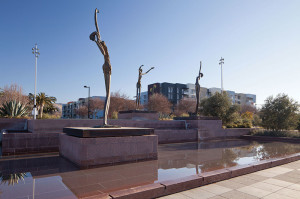Simpson Gumpertz & Heger Inc. was an Outstanding Award Winner for the East Station Plaza – Danseurs (Dancers) project in the 2014 NCSEA Annual Excellence in Structural Engineering awards program (Category – Other Structures).
Union City, California wanted to develop a civic plaza to the east of the Union City BART station. Although money was tight due to the economic downturn, the City allocated local grant funding for the plaza upgrades.
The architect for the project, Boris Dramov, FAIA, of ROMA Design Group, envisioned a centerpiece for the plaza – a terraced fountain with three bronze sculptured “Danseurs” – on platforms positioned within the fountain.
The sculptures were fabricated in France, and for a time, were displayed in the plaza on the north side of the Louvre in Paris. Union City officials, in conjunction with the architect identified the sculptures and the City purchased them before the design of the fountain commenced. At a pre-proposal meeting, Boris expressed a concern about the seismic performance of the sculptures. As shown by the photo, his concerns were well founded. Each sculpture is approximately 16 feet (5 m) tall, weighs approximately 4,000 pounds (1,800 kg), and is very slender. The ankles of the sculptures are only approximately 6 inches in diameter. In addition, the Hayward fault is only 0.6 miles (1 km) northeast of the site. At the first sign of shaking, the sculptures would be severely damaged or possibly collapse if a conventional approach to the anchoring the sculptures was used.
John Sumnicht, principal-in-charge, suggested mounting the sculptures on base isolated platforms to address this challenge. The concept of an isolated platform is similar to that used in base isolated buildings – put the object on a suspension with springs and shocks to reduce the lateral forces on the object – but on a smaller scale. This was the only scheme that had a chance of protecting the sculptures without obtrusive and objectionable external bracing.
John Meyer and Ron Mayes, both with Simpson Gumpertz & Heger, Inc. (SGH), first proposed isolated floors a number of years ago when they were working for a biotech company on how to protect high value equipment or product from damage during strong ground shaking. They proposed mounting the high-value equipment and product on isolated floors. They worked with Dynamic Isolation Systems (DIS) to develop an early prototype utilizing small platforms with a rubber isolator and dampers. DIS took the concept and developed a system that relies on springs and cables.
The isolation system used for the sculptures utilizes cross-linear bearings and a bi-directional spring unit that acts as the energy dissipation element and the spring. The hysteretic behavior of the spring unit is unconventional, with bilinear and different ascending and descending branches. The stiffness of the three branches (K1, K2, and Kr) is a function of the spring stiffness, and each can be adjusted to optimize the desired isolator behavior.
The program, Design Ground Motion Library, developed by AMEX Geomatrix Consultants, Inc., was used to develop the ground motions. The ground motions were then scaled to the response spectrum for the East Union Plaza site.
An analytical model of a sculpture on top of the isolation floor was developed using SAP2000. The sculptures and steel platform were modeled as linear elastic elements, and the spring unit was modeled with non-linear elements that followed the force-deformation response.
In evaluating the seismic performance of the sculptures, the accelerations that the sculpture would experience and the stresses that would develop in the ankles of the sculptures were of paramount concern. For the Design Earthquake (DE) event, the average acceleration of the seven time histories at the center of mass of the sculpture, if the sculptures were rigidly attached, is 1.30g. When evaluating the stresses in the ankles, the average demand-to-capacity ratio (DCR) for a rigidly attached sculpture is 4.95. The DCR is an indicator of the ductility demand or inelastic deformation that will occur at the ankle location resulting in a rotation of the statue from the vertical position. If the sculptures are rigidly attached to the base, it is clear that a hinge would form at the base of the sculptures resulting in collapse during moderate to strong ground shaking.
With the isolated platform, for the DE event, the average displacement of the seven time histories is 20 inches, the average acceleration is reduced to 0.2g, and the average DCR for the stress in the ankles is reduced to 1.04. With a DCR of 1.04, little to no damage of the sculpture during a DE ground shaking is expected.
The isolation platforms were beautifully incorporated into the fountain by placing them on stone-clad pedestals, artfully arranged in the fountain. In addition, the platforms are clad in stone and bronze to transition seamlessly from the pedestals to the statues.
Through the use of isolated platforms SGH was able to provide the architect and City an elegant solution to protecting their civic sculptures from earthquake damage. The total construction cost for the project was approximately $5,700,000.▪

